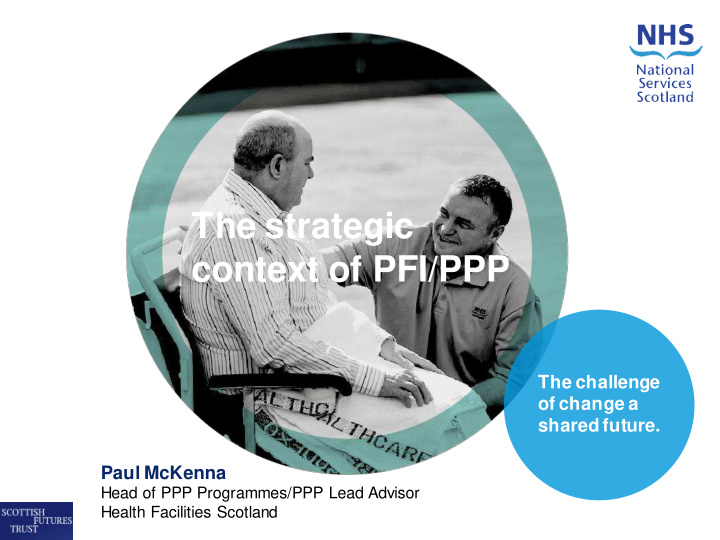



The strategic context of PFI/PPP The challenge of change a shared future. Paul McKenna Head of PPP Programmes/PPP Lead Advisor Health Facilities Scotland
PPP Specialist Support Team Awareness Involvement Continuous improvement and increasing value Commitment
Scope and scale: UK Capital Value Unitary Charge Total Unitary charge Number of PFI/PPP Department Forecast projects Department of Health 12,083 2,025 66,315 123 Ministry of Defence 9,043 1,838 31,871 41 Department for 7,879 1,238 27,592 62 Transport Department for education 7,800 1,082 22,254 168 Other departments 14,060 3,299 51,284 251 Scottish 6,175 985 22,284 93 Government Total 57,040 10,467 221,600 738
Scope and scale: Scale : Total Capital value of £6.1bn Further Education 9% 11% Local Authority Health 58% 22% SE & agencies Water & Sewerage Police
Scope and scale: NHS Scotland 1600 1400 Capital Value 1200 Unitary charge 1000 800 600 400 200 0 Operational In Construction In Development
Scope and scale: Unitary charge expenditure forecast 2006-07 2007-08 400.0 2008-09 350.0 2009-10 2010-11 300.0 2011-12 2012-13 250.0 2013-14 200.0 2014-15 2015-16 150.0 2016-17 2017-18 100.0 2018-19 50.0 2019-20 2020-21 0.0 2021-22 2022-23 2023-24 2024-25 2025-26
The challenge : Contract Policy Clinical Culture Resources types Change Changes
What we set out to do: • NHS Scotland has 38 operational PPP/PFI Facilities • A mixed landscape of contract types both PFI/PPP • Specialist Support team formed in 2014 to support boards in their management of these contracts FY14-15 FY16 – onwards FY15-16 Initial roll out New targets established Review programme and training delivered. Reviews Board level and strategic undertaken Further refinement of resource models process. established. Savings target Standardised models of achieved working.
Performance, value for money and continuous improvement
Key priorities and approach • Equipping and empowerment of Boards • Systemic approach to Boards • Maximizing value for money • Benefits retained by boards • Ensuring service provision is safe and compliant • Simplified process (scalable & agile) • Measurable and sustainable performance Definition Implementation Improve Control
Overview of Support model Pre operational start Operational Phase End of Contract In depth reviews Operational Support for variations End of Contract support readiness reviews Review of potential Refinancing Engagement with SPVs Training Increasing Board commitment and ownership - Practitioners Group
Readiness analysis: • Initial support to projects that are typically 6 months from operational commencement. • The key elements of this support are focused on ensuring that the Boards are aware of how the contract is structured, the key mechanisms and obligations within the contract. • This analysis also considers both Project Co. and the Boards management structures to ensure that robust and sustainable arrangements are in place and that lines of communication are clear .
Project reviews: • Focused on a detailed assessment of the projects performance which is performed following around 6 months of a new projects operation, to establish the performance of the contract and the robustness of actions taken following the readiness analysis. • Reviews are also conducted on established projects to assess the performance of the contract, quality of service received and the value for money gained from these services.
Implementation support: • This provides Boards with either short to medium term support or ad hoc support in implementing the agreed action plans following either the readiness review or project review activity End of Contract support: • Preparatory work prior to the end of the contract, management of the handover and future use of the project assets
SPV engagement: • Strategic engagement with SPVs with portfolios of contracts to establish where common performance or initiatives can be addressed (e.g. Helpdesk/ energy efficiency) Training: • Provision of either bespoke training packages to address specific Board needs or generic training to address best practice or knowledge gaps that are identified through the programme.
PPP Governance Model Strategic Operational Joint Support Board NHS Management Boards Practitioners Group Best Practice
Successes and benefits
Financial and Non Financial Benefits Cash Releasing Cost avoidance Value Improving Non Financial Utilisation of the Change Service response Enhanced patient Facilities Provisions : times environment limiting increased costs Utilities Change in law: Improved Greater staff / management limiting maintenance patient satisfaction standard increased cost Availability Benchmarking Enhanced Utilities and Market procurement productivity Testing Lifecycle Improved management relationships with service providers
Lessons Learnt • Proactive rather than reactive – Not only the operational phase . • Board level structures required – Board level ownership and governance – Board level resourcing – Contract knowledge and confidence • Operational contract management – Monitoring Calendar – Risk Register – Variation Management • Hand back liability – Life Cycle Management • Relationship with and role of Project Co
Sustainable performance management Maximising value for money Commercial Management Strategic Operational Innovation Proactive Planning Management and Management Partnership
Summary - Active participation Specialist PFI/ PPP Health Support Providers Boards Team • Increased value for money • Sustainable and measurable benefits • Improved performance and assurance • Planned and agile support • Ongoing development
Chair: Brendan Smyth Divisional Director Construction Division Department of Finance Questions to Paul McKenna Health Facilities Scotland the panel Donna Stevenson Scottish Futures Trust Mark Pillans Scottish Futures Trust The strategic context of PFI/PPP
Recommend
More recommend